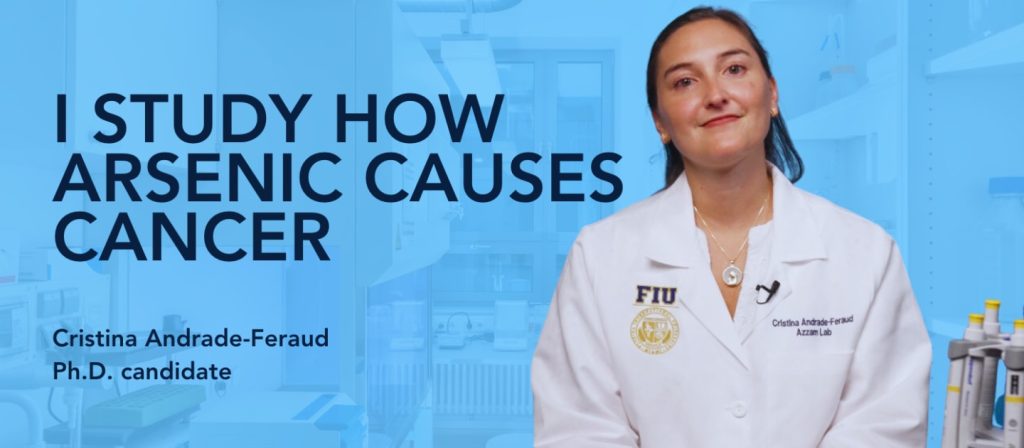Originally published on December 1, 2023 on news.fiu.edu
Written by Angela Nicoletti
Cristina Andrade-Feraud has seen how healthy cells change after exposure to arsenic. The transformation is radical. Exploding exponentially in size, the cells end up looking like “monsters,” she says.
A Ph.D. candidate in the lab of FIU cancer researcher Diana Azzam, Andrade-Feraud is unraveling the mystery of how arsenic causes these cells to turn ginormous and cancerous. It’s the first step in, one day, stopping those monsters before they even have a chance to appear.
Now, Andrade-Feraud is sharing a behind-the-scenes look at how a cancer diagnosis in her family encouraged her to pursue cancer research, what questions she’s trying to answer in the lab and more.
How did you get into cancer research?
I’ve been interested in cancer research since high school but was determined to pursue it when my grandfather passed away from prostate cancer. My parents always supported my interest in science and wanted me to discover what I was most passionate about, so I interned in various research labs during the summers as an undergraduate student and even shadowed various doctors and realized that my passion lies in the world of research.
The missing piece to my puzzle was found during a class I took while getting my master’s degree here at FIU. I learned about the harmful toxic metals present in coal ash, such as arsenic, cadmium, lead, chromium and more — and how people can be exposed to coal ash mostly through the air and water. This really opened my eyes because I found what I was interested in: The relationship between the environment and cancer.
What interests you most about the work you are doing?
The fact that millions of people around the world are exposed to arsenic — a toxic metal — through contaminated food and water. Additionally, the number of studies that have linked arsenic to various cancers makes it crucial to understand what we consume in our food and water.
So, how did you get started? How did you settle on arsenic?
When I first started my Ph.D. with Dr. Azzam, she allowed me to choose what I wanted to study. I am grateful for this because not many students have the opportunity to form a project from zero.
I read so many papers and created a literature review of all the metals and pesticides I was interested in and how they affect different organs. Obviously, I couldn’t do all the exposures I was interested in, so I selected five metals. I began with arsenic. And I never stopped!
In the lab, I have been exposing the ovarian and fallopian tube cells from healthy donors to arsenic at environmentally relevant concentrations — that means a concentration of arsenic that many populations are exposed to, mainly through water — and have observed drastic changes after three weeks. Now, we’re characterizing these cells and identifying a possible mechanism to determine how arsenic forms these giant cells.
What is one thing from your research that has surprised you?
Although there are almost 4,000 studies linking arsenic and cancer, my project focuses specifically on ovarian cancer. As recent studies suggest, arsenic targets the ovary and can play a role in the development of ovarian cancer.
I am surprised that although arsenic has been studied for decades, many unanswered questions remain. For example, it is concerning that arsenic can lead to the development of cancer, but the underlying mechanism leading to arsenic-induced cancers and how arsenic exposure leads to ovarian cancer is not fully understood.
Do you hope to continue this research long-term? What’s next?
In the near future, I plan to finish my Ph.D. and pursue a career in industry or the government. Who knows? Maybe we can help reduce the legal limit of arsenic in the drinking water! But I definitely hope to continue doing research long-term.
I like to think that one day I can delay the onset or possibly prevent certain environmentally induced cancers or simply provide information and educate people on protecting themselves from possible environmental pollutants.
The most rewarding aspect of my research and what really drives me every day is the fact that my work in the lab is translational, and every piece of information collected brings us one step closer to reducing the incidence of cancer around the world and improving public health.
How is exposure to arsenic a global public health concern?
Arsenic is a naturally occurring element found in the Earth’s crust. Exposure to arsenic, often through contaminated food and water, is associated with various negative health effects, including cancer.
Arsenic exposure is a global public health issue. A 2020 study estimated that up to 200 million people wordwide are exposed to arsenic-contaminated drinking water at levels above the legal limit of 10 parts per billion set by the U.S. Environmental Protection Agency and World Health Organization. More than 70 countries are affected, including the United States, Spain, Mexico, Japan, India, China, Canada, Chile, Bangladesh, Bolivia and Argentina.
Read more in the article Cristina Andrade-Feraud and Diana Azzam wrote in The Conversation.

